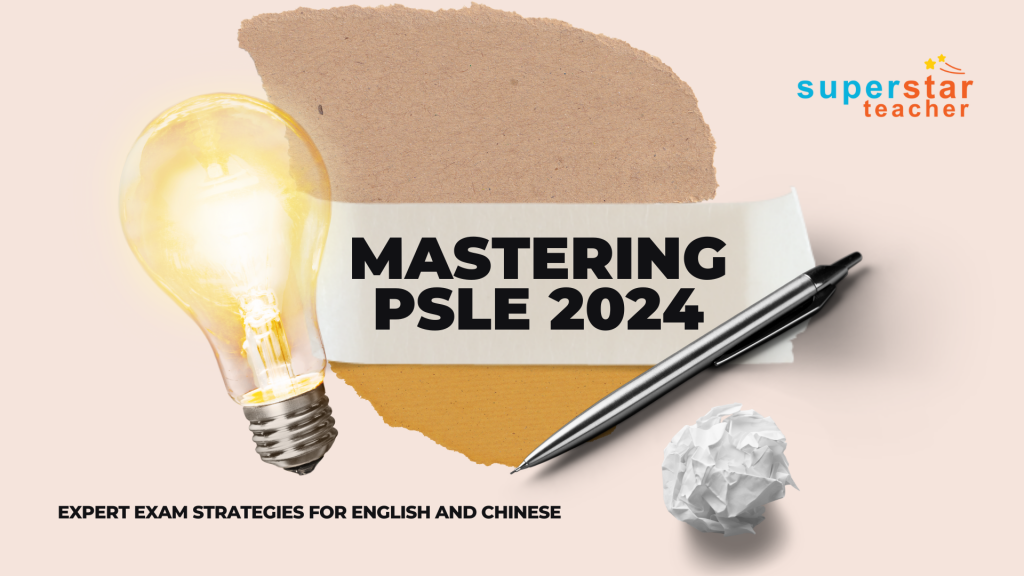Mastering PSLE 2024: Expert Exam Strategies for English and Chinese
As the PSLE 2024 examinations draw closer, it’s imperative for parents and students alike to adopt effective exam strategies to optimise performance in both English and Chinese subjects. In the following sections, we’ll provide a detailed overview of the PSLE English and Chinese exam formats, along with expert recommendations on time allocation and essential exam strategies for success. Whether your child is preparing to tackle the written papers or gearing up for the oral and listening comprehension components, this guide aims to equip you with the insights and resources needed to support them every step of the way.

PSLE English Exam: Decoding the Components
The PSLE English examination encompasses various components designed to evaluate students’ language proficiency, comprehension skills and communication abilities. Understanding the nuances of each section is essential for effective preparation and optimal performance.
In Paper 1, students are tasked with demonstrating their writing prowess through two distinct segments: Situational Writing and Continuous Writing.
- Situational Writing: This segment presents students with real-life scenarios or prompts, requiring them to craft a concise and purposeful response. Emphasis is placed on clarity of expression, coherence and appropriateness of language.
- Continuous Writing: Students are challenged to weave a narrative or argumentative piece based on given topics or visual stimuli. With a focus on creativity, organisation and language proficiency, students have the opportunity to showcase their writing flair and linguistic dexterity.
- Our Recommendations: To optimise performance in Paper 1, allocate 15 minutes for Situational Writing and 55 minutes for Continuous Writing. Utilise dedicated time for planning, writing and reviewing to ensure a comprehensive and polished response. By implementing effective storytelling exam strategies, it will help you captivate your readers and leave a lasting impression.
Paper 2 evaluates students’ language skills and comprehension abilities through a combination of multiple-choice and open-ended questions.
- Covering areas such as vocabulary, grammar, editing and synthesis, this paper demands a keen understanding of textual and visual information.
- Our Recommendations: Strategically divide your time to optimise performance in Paper 2. Allocate 30 minutes for the multiple-choice questions in Booklet A and 60 minutes for Booklet B. Reserve the remaining 20 minutes for comprehensive review and revision, ensuring a thorough and polished response. To excel in Open-Ended Comprehension, employ the ACE strategy taught by Teacher Monica, leveraging on effective techniques to analyse, comprehend and evaluate textual content.
The Listening Comprehension (Paper 3) component assesses students’ ability to understand spoken English. Through a series of auditory stimuli, including pictorial representations and verbal prompts, students are required to answer multiple-choice questions based on their comprehension of the material.
In the Oral Communication (Paper 4) segment, students demonstrate their oral proficiency by reading aloud and engaging in a stimulus-based conversation. Pronunciation, fluency and articulation are key factors in this component, as students express their thoughts and ideas with clarity and confidence.
Cracking the PSLE Chinese Exam: Navigating the Assessment Landscape
The PSLE Chinese exam consists of four key components, each designed to evaluate different aspects of students’ language skills and comprehension abilities.
The Composition Writing (Paper 1) component challenges students to showcase their linguistic flair and narrative skills.
- Students are presented with prompts or visual stimuli and tasked with crafting compelling compositions. Whether it’s based on given outlines or images, students must demonstrate coherence, creativity and linguistic precision in their writing.
- Our Recommendations: Given that electronic dictionaries are allowed for this section, it’s essential to ensure that your child is equipped with approved resources. Encourage them to leverage these tools effectively to enhance their writing and vocabulary.
Chinese Paper 2 is a written exam which evaluates students’ mastery of Chinese language through a combination of multiple-choice and open-ended questions.
- Covering areas such as vocabulary, grammar and comprehension, this paper requires students to demonstrate a deep understanding of the Chinese language and its nuances.
- Our Recommendations: Focus on honing skills in Chinese comprehension, a component that many students find challenging. Utilise exam strategies and techniques taught by Teacher Li Lim to navigate comprehension passages effectively and extract key information.
The Oral and Listening Comprehension (Paper 3) components offer students an opportunity to earn valuable marks through effective communication and comprehension skills.
- During the oral component, students engage in reading aloud and stimulus-based conversations with examiners. Pronunciation, fluency and articulation play pivotal roles in this segment, as students express their thoughts and ideas confidently.
- In the listening component, students are required to listen to various genres of Chinese passages and answer multiple-choice questions based on their comprehension. Effective listening skills and attention to detail are essential for success in this segment.
- Our Recommendations: The oral and listening components offer a significant opportunity for students to secure marks. With detailed practice and focused preparation, students can maximise their performance in these sections, contributing to overall exam success.
Empowering Your Child for PSLE Success
About Superstar Teacher
Welcome to Superstar Teacher, where learning meets excitement! As Singapore’s leading online learning platform, we are dedicated to set your child ahead in their academic journey.
Our curriculum is meticulously crafted to align with the latest MOE syllabus, offering dynamic modules for Primary and Secondary students, fostering advanced learning and building a solid foundation. Additionally, our personalised one-on-one sessions make homework enjoyable and manageable, providing tailored support for your child. Our ultimate goal is to achieve exam success for every child. With our competency-based approach, rest assured that your child is equipped with essential skills, gaining insights into question trends and powerful answering techniques.
Join us today and unlock a lifetime of learning success with Superstar Teacher!



